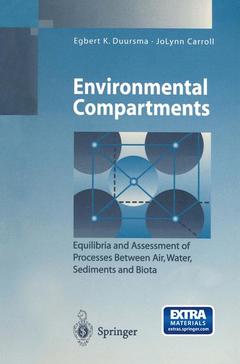Environmental Compartments, Softcover reprint of the original 1st ed. 1996 Equilibria and Assessment of Processes Between Air, Water, Sediments and Biota Environmental Science Series
Langue : Anglais
Auteurs : Duursma Egbert K., Carroll JoLynn

Any concentration of a substance measured in a living or non-living system results from its distribution among all of the environmental compartments: air, water, sediments, and biota. The transfer of a substance from one compartment to another is regulated by physical forces and the chemical properties of the substance and also those of the compartments. When transfer processes are nearly constant in time, a substance will achieve predictable equilibria distributions. It is of utmost importance that students, environmental scientists, and policymakers understand the basic processes which control the distribution of a substance in order to interpret measurements obtained from within a limited number of compartments.
1 Introduction.- 2 Processes and equilibria between compartments.- 2.1 Principles.- 2.2 Phases or compartments.- 2.2.1 Water.- 2.2.2 Particulate matter (PM).- 2.2.3 Bottom sediments.- 2.2.4. Living organisms.- 2.3 Processes and equilibria.- 2.3.1 Processes/equilibria in the liquid sea water compartment.- 2.3.2 Processes/equilibria between water and particulate matter compartments.- 2.3.3 Processes/equilibria between water and living compartments.- 3 Complexing metal- and radionuclide-sediment reactions.- 3.1 Complexation of metals by dissolved organic matter.- 3.1.1 Experiments of competition between complexation and adsorption.- 3.2 Results on radionuclide sorption by marine sediments.- 3.2.1 Methodologies of Kd determination.- 3.2.2 Dependency of Kds on concentrations in solution and amounts of PM in suspension and in consolidated sediments.- 3.2.3 Correlations of Kds with sediment and metal properties.- 3.2.4 Intercomparison of Kd determinations.- 4 Diffusion principles.- 4.1 Theories.- 4.1.1 Diffusion from constant and instantaneous sources.- 4.1.2 Diffusion and sorption.- 4.2 Simple methods of determining diffusion coefficients.- 4.2.1 Constant source technique.- 4.2.2 Instantaneous source technique.- 4.3 Experiments on hindrance of diffusing ions in sediments.- 4.3.1 Mean Free Path.- 4.3.2 Temperature.- 4.3.3 Electrical potential retention in pore water.- 4.3.4 Surface action.- 4.3.5 Effect of hydrostatic pressure on diffusion in sediments.- 4.4. Summary on effects on molecular diffusion in bottom sediments.- 5 Organochlorines.- 5.1 Introduction.- 5.2 PCB and DDT behaviour in water, PM and sediment compartments.- 5.2.1 Partitioning of PCBs between water and PM.- 5.2.2 DDT and PCB behaviour in organisms.- 5.3 The eel case.- 5.3.1 Introduction.- 5.3.2 A simulation experiment.- 5.3.3 Discussion.- 5.4 Pesticide use and contamination with Tambak (Indonesian brackish-water) aquaculture.- 5.4.1 Environmental contamination in the tropics.- 5.5 Possible DDT and PCB partitioning between air and man.- 6 Competitive reactions and effects of conservativity.- 6.1 Introduction.- 6.4 Principles of conservativity.- 6.3 Model study of competitive processes in an estuary containing a turbidity maximum.- 6.3.1 Boundary conditions.- 6.3.2 Reactions.- 6.3.3 Simulation model.- 6.3.4 Results and discussion.- 6.4 Residence times of metals in an estuary.- 6.4.1 Theory.- 6.4.2 Example of river branch.- 6.5 Sources and sinks of chemical constituents in estuaries.- 6.5.1 Introduction.- 6.5.2 The Ganges-Brahmaputra river-estuarine zone.- 6.5.3 Ba and 226Ra Distributions.- 6.5.4 Sources of Ba and 226Ra.- 6.5.5 Fluxes of Ba and 226Ra.- 7 Examples of distribution patterns in estuaries and seas.- 7.1 Budget of plutonium and some other nuclides in an estuary.- 7.2 Metals in the Western Mediterranean.- 7.3 PCB budgets.- 7.3.1 Western Mediterranean.- 7.3.2 Baltic.- 7.3.3 Antarctic atmosphere.- 7.3.4 Hypothetical global PCB equilibrium between atmosphere, water and man.- 7.4 The food chain accumulation paradox.- 8 Nuclear waste in the Kara Sea.- 8.1 Introduction.- 8.2 History of radioactive waste dumping in the Kara Sea.- 8.3 Inventory of dumped objects.- 8.4 Environmental concentrations of radionuclides.- 8.5 Predicting future radionuclide releases.- 8.6 Modelling radionuclide dispersion.- 8.6.1 Radionuclide exchange processes.- 8.6.2 Approaches to determining site-specific Kds.- 8.6.3 Theoretical investigation of site-specific Kds.- 8.6.4 Laboratory determinations of distribution coefficients.- 8.6.5 Field experimentation.- 8.6.6 Summary of findings.- 8.6.7 Models for predicting radionuclide dispersion.- 8.7 Impact assessment.- 8.7.1 Global impacts.- 8.7.2 Regional impacts.- 8.7.3 Local impact.- 8.7.4 Conclusions.- 9 Globel oceanic and atmospheric stability of oxygen.- 9.1 Oxygen budgets.- 9.1.1. Globel budgets.- 9.1.2 Oxygen and exhaust gasses between a population centre and atmosphere.- 9.2 Relation to CO2 budgets.- 9.2.1 Atmosphere and ocean budgets.- 9.2.2 The Antarctic paradox.- 9.3 Time-dependent process.- 9.3.1 Environmental effects on photosynthesis and respiration.- 9.3.2 Short time scale oxygen regulatory feedbacks.- 9.3.3 Global short-term feedback possibilities.- 9.3.4 Final conclusion.- 9.4 Future limit(s) of ocean pH due to fossil-fuel produced CO2.- 10 Case studies on Environmental Impact Assessment (EIA).- 10.1 Introduction.- 10.2 Techniques.- 10.2.1 Environmental Impact Assessment (EIA).- 10.2.2 Best Professional Judgement (BPJ).- 10.3 A Delta-case EIA study.- 10.4 Assessment of diffusion of radionuclides from potential HLW disposal.- 10.5 Amoeba assessment.- 10.6 COSMO-BIO assessment.- Appendix I: Answers to a question and exercises.- Appendix II: Kara Sea box model user information.- Appendix Ills COSMO-BIO assessment.- References.
Any concentration of substances in the environment is the result of their distribution among the compartments : air, water, sediments, and biota. The transfer process from one compartment to another is regulated by the chemical properties of these substances and those of the compartments. For a great number of contaminants the distribution processes tend to reach equilibria, when time is a factor involved. Students scientists, and policymakers will get an understanding of the basic distribution processes of environmental contaminants in the environment in order to interpret measurements from a limited number of compartments. Two demo models are given on diskette, one showing radionuclide transport from a dumped nuclear waste, the second the role of biodiversity in coastal zone management.
Date de parution : 11-2013
Ouvrage de 279 p.
15.5x23.5 cm
Disponible chez l'éditeur (délai d'approvisionnement : 15 jours).
Prix indicatif 52,74 €
Ajouter au panierThèmes d’Environmental Compartments :
© 2024 LAVOISIER S.A.S.


